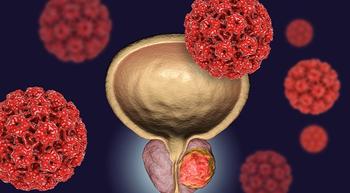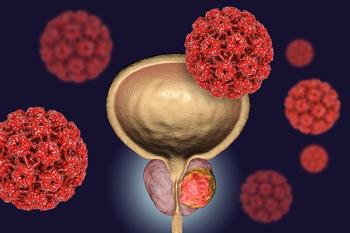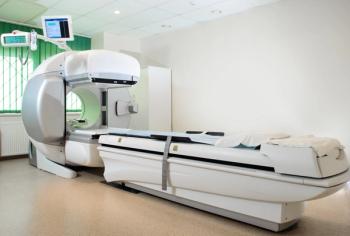
Prostate Cancer
Latest News
Latest Videos

More News

The combination of Erleada, Zytiga and the steroid prednisone was associated with a trend toward better survival outcomes in certain patients with chemotherapy-naive metastatic castration-resistant prostate cancer.

Instead of buying your sweetheart chocolates for Valentine’s Day this year, one cancer survivor suggests people get screened as a gift to their significant other.

Patients with prostate cancer experienced no significant difference in quality of life when treated with two different types of radiation regimens, recent research has found.

At three years, overall survival in men with nonmetastatic, castration-resistant prostate cancer treated with Nubeqa was 83% compared with 77% in those who received placebo.

Men who are receiving androgen deprivation therapy treatment for prostate cancer experience higher levels of fatigue and depression when compared to men who are not receiving treatment and who have no history of cancer.

Lynparza demonstrates a significantly longer duration of survival compared Xtandi or Zytiga for men with metastatic prostate cancer, one study found.

Researchers observed the benefit of adhering to a Mediterranean diet in all men, in addition to non-White men and those without diabetes.

Generations of cancer leads to the risk that must be addressed head-on, but the lessons we can take from our own family members who have had cancer is valuable to pass on.

Orgovyx is the first oral drug to treat patients with advanced prostate cancer, who were previously treated with intravenous drugs that required clinic visits.

While the current field of prostate cancer research is experiencing an era of “warp speed developments,” perhaps the most exciting option on the horizon is theranostics, according to Dr. Phillip J. Koo.

The radioactive diagnostic agent, Gallium 68 PSMA-11, can detect suspected prostate cancer metastasis or recurrence, providing another imaging option for these patients.

The field of theranostics is growing, and its impact could change the future of prostate cancer treatment. CURE® discusses this potential with a theranostics expert.

The FDA approved this liquid biopsy to check blood for prostate-tumor DNA that indicates the presence of genetic mutations or rearrangements. The test was also recently approved for use in patients with ovarian, non-small cell lung or breast tumors.

In an interview with CURE®, Dr. Phillip J. Koo defines what theranostics is, discusses the treatment’s potential and answers questions patients may have regarding its safety.

From a Canadian man shaving his moustache for the first time in nearly 50 years to participate in Movember to HGTV’s “Flip or Flop” host Tarek El Moussa discussing his journey with testicular and thyroid cancer, here’s what’s happening in the cancer landscape this week.

In a candid announcement on Friday, November 6th, famed Today Show host Al Roker announced his recent prostate cancer diagnosis and prognosis.

Treatment with a novel immuno-oncology therapy demonstrated a manageable safety profile with preliminary efficacy in patients with metastatic castration-resistant prostate cancer.

As the wife of a prostate cancer survivor, I’m eternally grateful for Colorado’s early blood draw program that helped my husband get lifesaving treatment early.

The novel coronavirus that led to the COVID-19 pandemic has been a constant fixture, not dissimilar to how cancer hangs over our lives as well.

View the full CURE® Educated Patient® Summit on Prostate Cancer here!

Men may experience erectile dysfunction and incontinence after receiving treatment for prostate cancer. However, there are devices — like a penile prosthetic and artificial urinary sphincter — that can help control those side effects associated with treatment.

Prostate cancer treatment can be detrimental to bone and muscle health, but an exercise regimen and healthy eating habits can help.

Some patients are better suited for surgery than others. In general, patients with widespread metastatic disease are also not good candidates for surgery, particularly if their cancer has spread beyond the prostate to areas like the liver, lungs, and bones.

Active surveillance can be used for many patients with prostate cancer; however, when localized, radiation therapy is an option.

Finding balance to detect and treat prostate cancer without overtreatment is important for patients.















